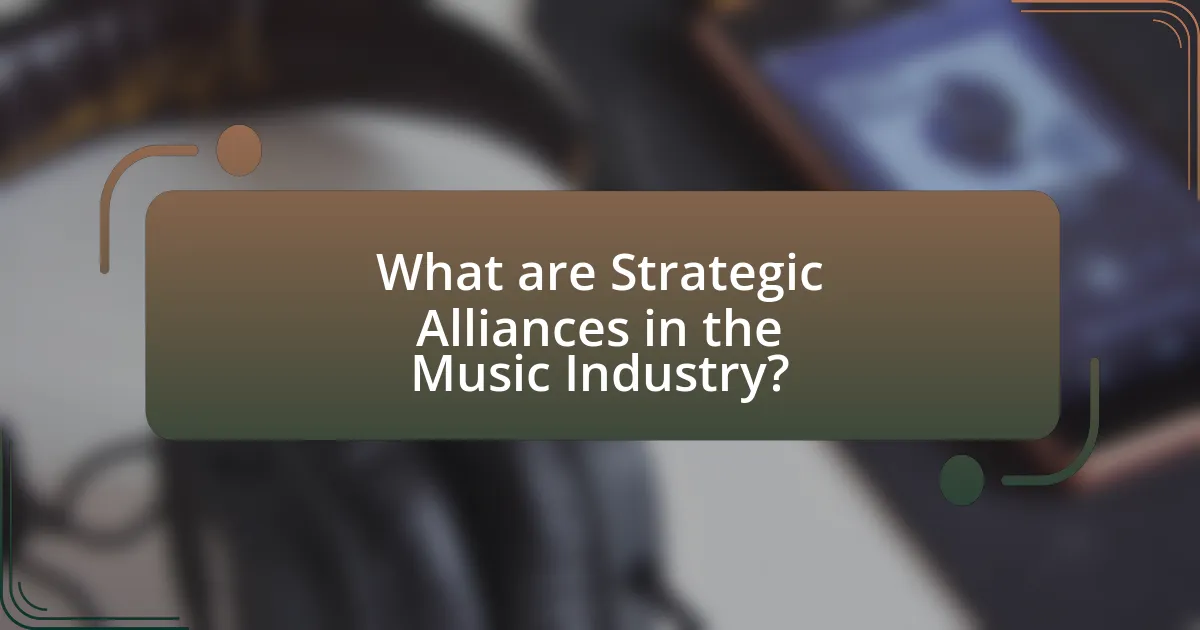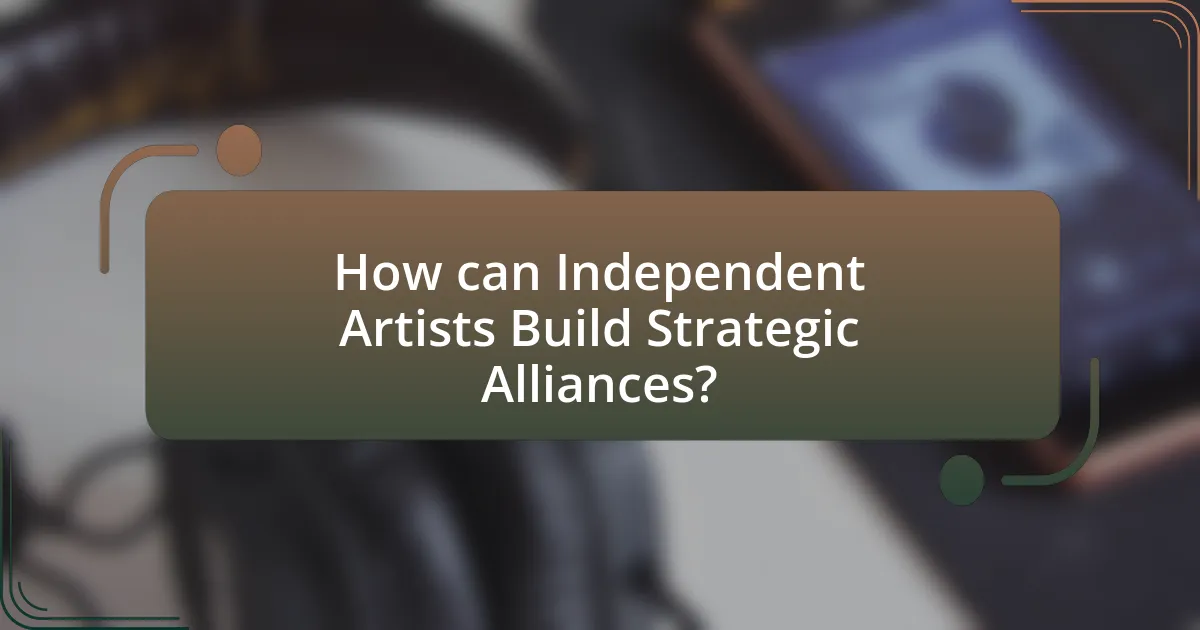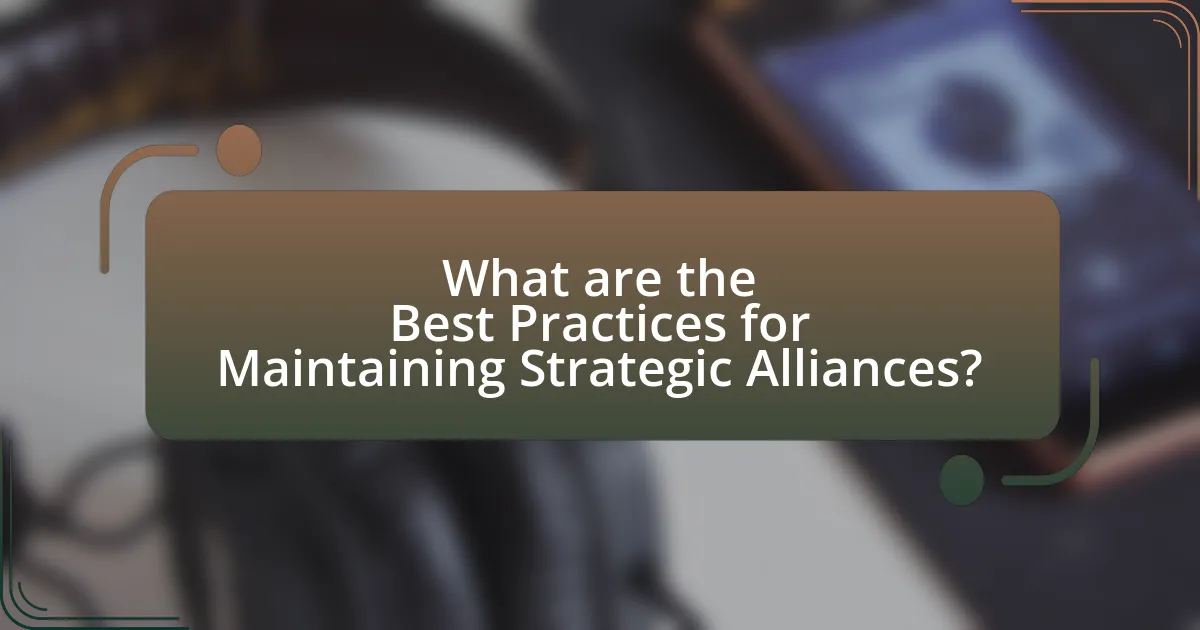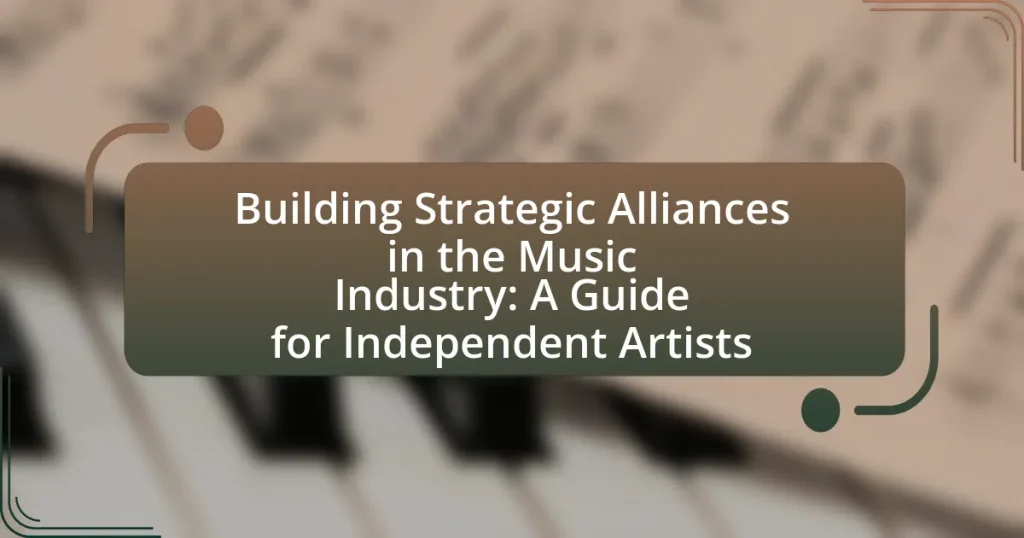The article focuses on building strategic alliances in the music industry, specifically for independent artists. It outlines the definition of strategic alliances as collaborative agreements that enhance market reach, share resources, and combine expertise among artists, record labels, and music publishers. Key benefits for independent artists include access to resources, networks, and promotional opportunities that can lead to increased visibility and revenue. The article also discusses various types of partnerships, the importance of mutual goals, and best practices for maintaining successful alliances, while addressing challenges faced by artists without such collaborations. Additionally, it provides practical tips for identifying potential partners and ensuring effective communication within partnerships.

What are Strategic Alliances in the Music Industry?
Strategic alliances in the music industry are collaborative agreements between two or more entities, such as artists, record labels, or music publishers, aimed at achieving mutual benefits. These alliances can enhance market reach, share resources, and combine expertise, ultimately leading to increased visibility and revenue for the involved parties. For instance, a well-known example is the partnership between artists and brands for sponsorships, which can provide financial support and promotional opportunities, thereby expanding the artists’ audience.
How do Strategic Alliances benefit Independent Artists?
Strategic alliances benefit independent artists by providing access to resources, networks, and promotional opportunities that they may not have on their own. These collaborations can lead to shared marketing efforts, increased visibility, and the ability to reach wider audiences through combined fan bases. For instance, partnerships with other artists or brands can enhance credibility and create unique content that attracts attention. Additionally, strategic alliances can facilitate access to funding, distribution channels, and industry expertise, which are crucial for independent artists navigating the competitive music landscape.
What types of partnerships can Independent Artists form?
Independent artists can form several types of partnerships, including collaborations with other artists, partnerships with producers, and alliances with brands or sponsors. Collaborations with other artists often lead to joint projects that can expand reach and audience. Partnerships with producers can enhance the quality of music production and provide access to industry networks. Additionally, alliances with brands or sponsors can offer financial support and marketing opportunities, which are crucial for independent artists seeking to grow their presence in the music industry.
How do these partnerships enhance an artist’s reach and visibility?
Partnerships enhance an artist’s reach and visibility by leveraging the networks and resources of collaborators. When artists partner with brands, other musicians, or influencers, they gain access to new audiences that may not have been reachable independently. For instance, a collaboration with a popular brand can result in exposure through marketing campaigns, social media promotions, and events, significantly increasing the artist’s visibility. Additionally, partnerships often provide financial support and promotional resources, which can lead to more extensive marketing efforts and higher-quality productions. This strategic alliance can be evidenced by the success of artists like Billie Eilish, who has collaborated with brands like Apple and Nike, resulting in substantial increases in her audience engagement and overall visibility in the music industry.
Why are Strategic Alliances important for Independent Artists?
Strategic alliances are important for independent artists because they provide access to resources, networks, and opportunities that enhance visibility and career growth. By collaborating with other artists, producers, and industry professionals, independent artists can leverage shared audiences and expertise, which can lead to increased exposure and potential revenue streams. For instance, a study by the Berklee College of Music highlights that artists who engage in partnerships often see a 30% increase in audience reach compared to those who work solo. This collaborative approach not only fosters creativity but also helps independent artists navigate the complexities of the music industry more effectively.
What challenges do Independent Artists face without alliances?
Independent artists face significant challenges without alliances, including limited access to resources, reduced market visibility, and difficulties in networking. Without alliances, independent artists often struggle to secure funding and promotional support, which are crucial for producing and marketing their music. For instance, a study by the Music Industry Research Association found that artists with collaborative partnerships are 50% more likely to achieve commercial success compared to those who operate solo. Additionally, the lack of alliances can hinder an artist’s ability to reach wider audiences, as collaborations often amplify exposure through shared fan bases and promotional efforts. Networking opportunities are also diminished, making it harder for independent artists to connect with industry professionals, which can lead to missed opportunities for gigs, collaborations, and mentorship.
How can alliances mitigate risks in the music industry?
Alliances can mitigate risks in the music industry by providing shared resources, expertise, and market access. By collaborating, independent artists can pool financial resources to reduce individual investment risks, share knowledge about industry trends, and leverage each other’s networks for broader audience reach. For instance, partnerships with established labels or other artists can lead to joint marketing efforts, which statistically increase visibility and sales. According to a study by the International Music Summit, artists who collaborate with others see a 30% increase in streaming numbers compared to solo efforts. This demonstrates that strategic alliances not only enhance creative opportunities but also significantly lower the financial and operational risks associated with music production and distribution.

How can Independent Artists Build Strategic Alliances?
Independent artists can build strategic alliances by networking with other musicians, industry professionals, and organizations that share similar goals. Engaging in collaborations, attending industry events, and utilizing social media platforms can facilitate these connections. For instance, a study by the Berklee College of Music highlights that artists who collaborate with others often experience increased visibility and access to new audiences, demonstrating the effectiveness of strategic partnerships in enhancing career growth.
What steps should Independent Artists take to identify potential partners?
Independent artists should conduct thorough research to identify potential partners by analyzing their target audience, industry trends, and existing collaborations. This involves utilizing social media platforms, music industry databases, and networking events to discover individuals or organizations that align with their artistic vision and goals. For instance, artists can use platforms like LinkedIn to connect with industry professionals or attend music festivals to meet potential collaborators. Additionally, reviewing successful partnerships within their genre can provide insights into effective alliances. By systematically evaluating these factors, independent artists can strategically identify partners that enhance their career trajectory.
How can networking events facilitate partnership opportunities?
Networking events facilitate partnership opportunities by providing a platform for individuals and organizations to connect, share ideas, and explore collaborative ventures. These events enable attendees to meet potential partners face-to-face, fostering trust and rapport that are essential for successful alliances. According to a study by the Harvard Business Review, 70% of jobs are found through networking, highlighting the effectiveness of personal connections in creating business opportunities. Additionally, networking events often feature industry leaders and experts who can offer insights and introductions, further enhancing the potential for partnerships.
What role do social media platforms play in finding collaborators?
Social media platforms serve as essential tools for independent artists to find collaborators in the music industry. These platforms facilitate networking by allowing artists to connect with other musicians, producers, and industry professionals globally. For instance, platforms like Instagram and Twitter enable users to showcase their work, engage with potential collaborators, and participate in music-related discussions, which can lead to partnership opportunities. According to a survey by the Music Industry Research Association, 70% of independent artists reported using social media to discover collaborators, highlighting its effectiveness in fostering connections within the industry.
How can Independent Artists approach potential partners?
Independent artists can approach potential partners by leveraging networking opportunities, utilizing social media platforms, and attending industry events. Networking allows artists to connect with industry professionals, while social media provides a direct channel to engage with potential collaborators and partners. For instance, platforms like Instagram and LinkedIn enable artists to showcase their work and establish relationships with brands and other artists. Additionally, attending music festivals, conferences, and workshops facilitates face-to-face interactions, which can lead to strategic partnerships. According to a study by the Music Industry Research Association, 70% of successful collaborations in the music industry stem from personal connections made at such events.
What strategies can be used to pitch collaboration ideas?
To effectively pitch collaboration ideas, independent artists should utilize targeted networking, clear value propositions, and tailored presentations. Targeted networking involves identifying and connecting with artists or industry professionals whose work aligns with one’s own, thereby increasing the likelihood of mutual interest. A clear value proposition articulates the benefits of collaboration, such as shared audiences or enhanced creativity, making the proposal more appealing. Tailored presentations should address the specific goals and styles of the potential collaborator, demonstrating how the partnership can achieve shared objectives. These strategies are supported by the fact that successful collaborations often stem from well-researched and personalized approaches, as evidenced by numerous case studies in the music industry where artists who took the time to understand their collaborators’ needs achieved more fruitful partnerships.
How important is it to establish mutual goals in partnerships?
Establishing mutual goals in partnerships is crucial for success. When partners share common objectives, it fosters collaboration, enhances communication, and aligns efforts towards achieving those goals. Research indicates that partnerships with clearly defined mutual goals are 30% more likely to succeed, as they create a sense of shared purpose and accountability among partners. This alignment not only improves decision-making but also increases the overall effectiveness of the partnership, making it essential for independent artists in the music industry to prioritize mutual goal-setting.

What are the Best Practices for Maintaining Strategic Alliances?
The best practices for maintaining strategic alliances include clear communication, mutual benefit, and regular evaluation of the partnership. Clear communication ensures that all parties understand their roles and expectations, which fosters trust and collaboration. Establishing mutual benefits is crucial, as it aligns the goals of each partner, making the alliance more sustainable. Regular evaluation allows partners to assess the effectiveness of the alliance, identify areas for improvement, and adapt to changing circumstances. Research indicates that successful alliances often involve ongoing dialogue and flexibility, which are essential for long-term success in dynamic industries like music.
How can Independent Artists ensure effective communication with partners?
Independent artists can ensure effective communication with partners by establishing clear expectations and maintaining regular updates. Clear expectations involve defining roles, responsibilities, and objectives at the outset of any partnership, which helps prevent misunderstandings. Regular updates, whether through scheduled meetings or consistent digital communication, foster transparency and keep all parties aligned on progress and challenges. Research indicates that effective communication can enhance collaboration and lead to more successful partnerships, as evidenced by a study published in the Journal of Business Communication, which found that organizations with strong communication practices experience 47% higher employee engagement and productivity.
What tools can facilitate ongoing collaboration and feedback?
Tools that can facilitate ongoing collaboration and feedback include project management software, communication platforms, and collaborative document editing tools. Project management software like Trello or Asana allows teams to track tasks and deadlines, ensuring everyone is aligned on project goals. Communication platforms such as Slack or Microsoft Teams enable real-time discussions and sharing of ideas, fostering a collaborative environment. Collaborative document editing tools like Google Docs or Microsoft Office 365 allow multiple users to work on documents simultaneously, providing instant feedback and revisions. These tools enhance productivity and streamline the collaboration process, making them essential for independent artists in the music industry.
How can regular check-ins strengthen partnerships?
Regular check-ins can strengthen partnerships by fostering open communication and ensuring alignment on goals. These consistent interactions allow partners to address concerns, share updates, and adapt strategies collaboratively, which enhances trust and accountability. Research indicates that effective communication is a key factor in successful partnerships, with studies showing that organizations with regular communication practices report higher satisfaction and performance levels. For instance, a study published in the Journal of Business Research found that frequent communication positively impacts relationship quality and partnership outcomes.
What are common pitfalls to avoid in Strategic Alliances?
Common pitfalls to avoid in strategic alliances include lack of clear objectives, misalignment of goals, and inadequate communication. Clear objectives are essential for guiding the partnership; without them, partners may pursue conflicting interests, leading to inefficiencies. Misalignment of goals can result in one party feeling undervalued or overburdened, which can jeopardize the alliance’s success. Inadequate communication can create misunderstandings and mistrust, ultimately undermining collaboration. Research indicates that 70% of strategic alliances fail due to these issues, highlighting the importance of addressing them proactively.
How can misunderstandings be prevented in partnerships?
Misunderstandings in partnerships can be prevented through clear communication and defined expectations. Establishing open lines of communication ensures that all parties can express their thoughts and concerns, reducing the likelihood of misinterpretation. Additionally, setting specific roles, responsibilities, and goals at the outset of the partnership helps to align expectations and minimize confusion. Research indicates that effective communication practices, such as regular check-ins and feedback sessions, significantly enhance collaboration and understanding among partners in various fields, including the music industry.
What should artists do if a partnership is not working out?
Artists should assess the partnership’s dynamics and communicate openly with their partner to identify issues. If the partnership remains unproductive after discussions, artists should consider redefining roles, setting clear expectations, or ultimately dissolving the partnership. Research indicates that effective communication and role clarity are crucial for successful collaborations in creative industries, as highlighted in studies on team dynamics and collaboration effectiveness.
What practical tips can Independent Artists implement for successful alliances?
Independent artists can implement several practical tips for successful alliances, including networking effectively, establishing clear communication, and setting mutual goals. Networking allows artists to connect with other musicians, producers, and industry professionals, which can lead to collaborative opportunities. Clear communication ensures that all parties understand their roles and expectations, reducing the likelihood of misunderstandings. Setting mutual goals aligns the interests of all involved, fostering a sense of shared purpose and commitment. These strategies are supported by research indicating that effective collaboration in creative industries often hinges on strong interpersonal relationships and shared objectives.
How can setting clear expectations improve collaboration?
Setting clear expectations improves collaboration by ensuring all parties understand their roles, responsibilities, and objectives. This clarity reduces misunderstandings and aligns efforts towards common goals, which is crucial in the music industry where independent artists often rely on teamwork for success. Research indicates that teams with defined expectations experience a 25% increase in productivity, as members are more focused and accountable. By establishing these parameters, artists can foster a more cohesive working environment, ultimately enhancing their strategic alliances.
What role does flexibility play in successful partnerships?
Flexibility is crucial in successful partnerships as it allows collaborators to adapt to changing circumstances and diverse needs. In the music industry, where trends and audience preferences can shift rapidly, partners who demonstrate flexibility can respond effectively to new opportunities or challenges. For instance, a study by the Harvard Business Review highlights that organizations with flexible partnerships are 30% more likely to innovate successfully, indicating that adaptability fosters creativity and resilience in collaborative efforts. This adaptability not only strengthens the partnership but also enhances the overall success of projects within the dynamic landscape of the music industry.
